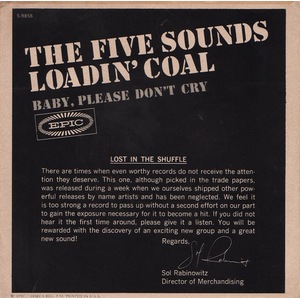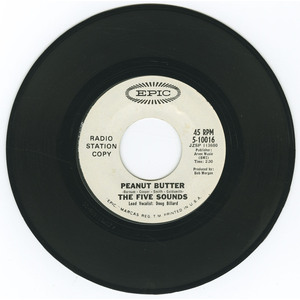Five Sounds
Websites:
No
Origin:
Halifax, Nova Scotia, 🇨🇦
Biography:
The Five Sounds / Central Nervous System: Halifax’s R&B Powerhouse Turned Psych-Funk Collective
The Five Sounds were a Halifax-based R&B and garage rock band active during the mid-to-late 1960s. Known for their tight arrangements, soulful edge, and powerful vocals, they were among the most popular Maritime bands of their era—and served as a vital launching pad for future Canadian rock talent.
1965–1966: Epic Singles and Radio Success
In 1965, the Five Sounds released their first single on Epic Records:
“Loadin’ Coal” b/w “Baby, Please Don’t Cry.” While the track didn’t break into national charts, it received strong airplay on Halifax’s CHNS and was later praised by Epic’s merchandising director Sol Rabinowitz, who called it a “worthy record” that had been “lost in the shuffle.” The single was singled out internally as being "too strong a record to pass up."
They followed it with a second release on Epic:
“Peanut Butter” b/w “Miss Ann.” This harder-edged garage R&B release, issued independently or with limited distribution, captured the band at their rawest and remains highly collectible today.
1968: CBC Television and National Exposure
By 1968, the Five Sounds had evolved into a professional house band and were hired to perform regularly on CBC Television’s "Where It’s At"—a youth-oriented variety show that aired nationally, with regional segments filmed in Halifax. The Halifax edition, hosted by Frank Cameron, gave the Five Sounds weekly visibility and connected them with CBC’s production infrastructure.
It was during this period that the group—pushing further into psychedelic and jazz-rock territory—began developing more original material under the direction of Keith Jollimore and Doug Billard.
1968–1969: Transition to Central Nervous System
Later in 1968, the Five Sounds traveled to New York City to record a full-length album at the legendary Record Plant. There, under the guidance of in-house contact Mark Joseph, the band changed their name to Central Nervous System, marking their full transformation into a horn-driven, progressive psych-funk ensemble.
The album, I Could Have Danced All Night, was produced by Tom Wilson (famed for his work with Bob Dylan and Frank Zappa), and engineered by Eddie Kramer, best known for his work with Jimi Hendrix, Led Zeppelin, and the Rolling Stones. The LP blended original material by Billard and Jollimore with covers, including a version of Lonnie Mack’s “Why”—a song not listed on the jacket.
The band was poised for a breakthrough, with U.S. tour dates scheduled and industry buzz building. However, Central Nervous System disbanded in 1969, just before the album had a chance to gain traction in the market. The LP—now a rare collector’s item—remains one of the most intriguing lost gems of Canadian psychedelic rock.
Legacy and Where They Went
After the split, band members dispersed into various corners of the Canadian rock world:
Doug Billard and Jim White both went on to perform with Pepper Tree, one of Nova Scotia’s most ambitious rock acts.
Richard Oakley transitioned to lead guitar and co-founded the progressive Halifax group Soma.
Keith Jollimore and Bruce Cassidy joined Lighthouse, the Toronto-based rock orchestra that would go on to win multiple Junos.
Joe Sealy, already a versatile pianist, became one of Canada's most celebrated jazz musicians, eventually receiving the Order of Canada for his contributions to the arts.
Though their name may have changed, the creative force behind the Five Sounds / Central Nervous System left an outsized legacy in Canadian music—bridging the soul-inflected energy of 1960s R&B with the ambition and boundary-pushing artistry of the country’s progressive rock movement in the 1970s.
-Robert Williston
Doug Billard: vocals
Jim White: guitar
Richard Oakley: bass
Jack S. Lilly: drums
Keith Jollimore: reeds
Bruce Cassidy: trumpet
Joe Sealy: keyboards


